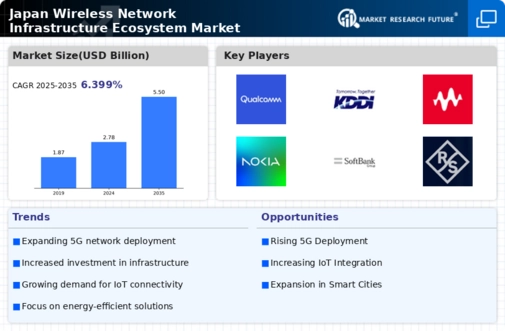The wireless network infrastructure ecosystem market in Japan is characterized by a dynamic competitive landscape, driven by rapid technological advancements and increasing demand for high-speed connectivity. Key players such as NEC Corporation (Japan), Nippon Telegraph and Telephone Corporation (Japan), and Fujitsu Limited (Japan) are strategically positioned to leverage innovation and partnerships to enhance their market presence. NEC Corporation (Japan) focuses on developing cutting-edge 5G solutions, while Nippon Telegraph and Telephone Corporation (Japan) emphasizes expanding its fiber-optic network to support growing data traffic. Fujitsu Limited (Japan) is investing in AI-driven network management systems, which collectively shape a competitive environment that prioritizes technological leadership and customer-centric solutions.
In terms of business tactics, companies are increasingly localizing manufacturing and optimizing supply chains to enhance operational efficiency. The market appears moderately fragmented, with several players vying for market share. However, the collective influence of major companies is significant, as they drive innovation and set industry standards, thereby shaping the overall market structure.
In November 2025, NEC Corporation (Japan) announced a strategic partnership with a leading telecommunications provider to deploy a nationwide 5G network. This collaboration is expected to enhance connectivity across urban and rural areas, reflecting NEC's commitment to expanding its technological footprint and addressing the diverse needs of consumers. The partnership underscores the importance of collaboration in achieving large-scale infrastructure projects.
In October 2025, Fujitsu Limited (Japan) launched a new AI-based network optimization tool aimed at improving operational efficiency for telecom operators. This tool is designed to analyze network traffic patterns and optimize resource allocation in real-time, which could significantly reduce operational costs and enhance service quality. The introduction of such innovative solutions indicates Fujitsu's focus on integrating advanced technologies into its offerings, thereby reinforcing its competitive position.
In September 2025, Nippon Telegraph and Telephone Corporation (Japan) unveiled its plans to invest ¥500 billion in expanding its fiber-optic infrastructure over the next five years. This investment aims to enhance broadband access and support the increasing demand for high-speed internet services. By prioritizing infrastructure development, NTT is positioning itself as a leader in the market, catering to the evolving needs of consumers and businesses alike.
As of December 2025, current trends in the wireless network infrastructure ecosystem market include a strong emphasis on digitalization, sustainability, and AI integration. Strategic alliances among key players are shaping the competitive landscape, fostering innovation and collaboration. The shift from price-based competition to a focus on technological differentiation and supply chain reliability is evident. Companies are likely to continue investing in innovative solutions that enhance customer experience and operational efficiency, indicating a forward-looking approach to competition in this rapidly evolving market.





















Leave a Comment